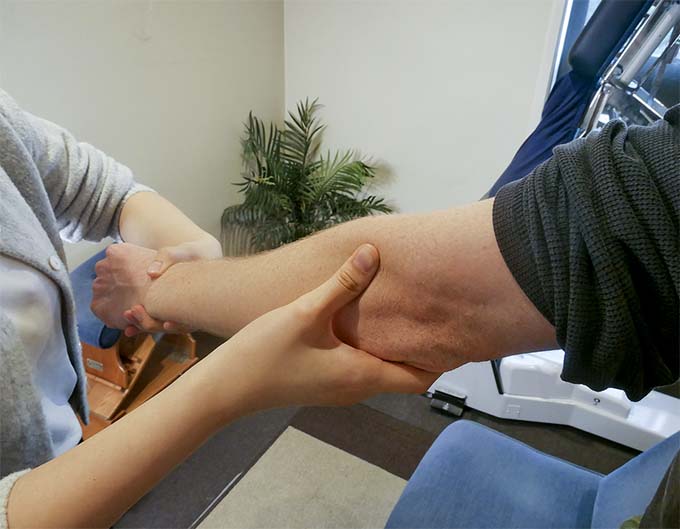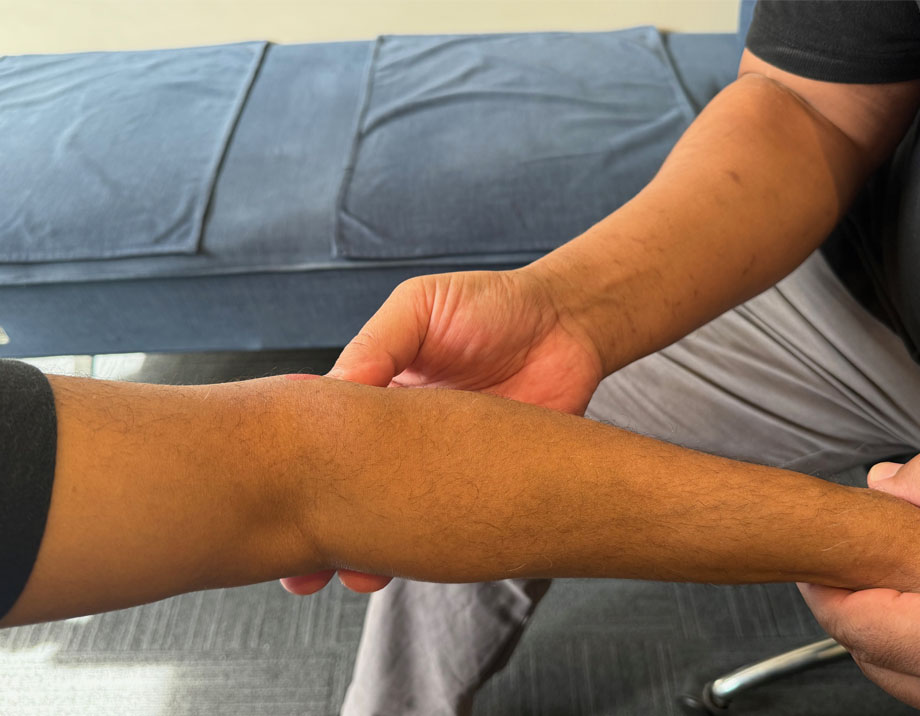Premier Melbourne Chiropractors
✓ Onsite Parking ✓ Wheelchair Access ✓ X-Ray - 424 Blackburn Rd, Glen Waverley VIC 3150
✓ Onsite Parking ✓ Wheelchair Access ✓ X-Ray
424 Blackburn Rd, Glen Waverley
Elbow Pain Conditions
We Diagnose, Treat And Manage Elbow Pain Issues.
Understanding Elbow Pain Conditions
Understanding elbow pain requires a look into the various activities and causes that can lead to discomfort in this joint. Commonly, elbow pain arises from repetitive motions or overuse, typical in activities such as tennis, golf, or manual labour. These repetitive actions can exert strain on the tendons and muscles surrounding the elbow, leading to inflammation and pain. Some of the most prevalent conditions are Tennis Elbow, Golfer's Elbow, bursitis and cubital tunnel syndrome, all are notable causes of elbow discomfort. While occasionally elbow pain resolves on its own with rest and care, persistent discomfort may require further attention. Dealing with such common issues is what our Chiropractors do daily. They are trained professionals with the knowledge and experience to diagnose, treat, and manage various conditions causing elbow pain. You can continue to explore this page to see in more detail the symptoms of various conditions that cause elbow pain.
Tennis Elbow (Lateral Epicondylitis)
Tennis elbow, medically known as lateral epicondylitis, is a common condition that causes pain around the outside of the elbow. It occurs when the tendons in the forearm become overloaded, usually due to repetitive motions of the wrist and arm. Despite its name, tennis elbow can affect anyone who performs activities that require similar arm movements, such as painters, plumbers, and carpenters. The main symptom is a painful burning sensation on the outer part of the elbow, which sometimes extends into the forearm and wrist. The pain can be worsened by activities that involve gripping, lifting, or twisting motions. Tennis elbow is often referred to as an overuse injury because it can develop gradually over time. It typically affects people in their dominant arm, but it can also occur in the non-dominant arm or both arms simultaneously. It's most common between the ages of 30 and 50 and it affects men and women equally. Improper technique while playing tennis is probably the most common cause and with tennis being an extremely popular sport around Melbourne, it’s no wonder we frequently treat people with this condition.

Chiropractic Treatment For Tennis Elbow
If left untreated, tennis elbow can become a chronic condition that significantly impacts daily activities and quality of life. In addition to pain, individuals with tennis elbow may experience weakness in their grip and difficulty performing simple tasks such as holding a cup or turning a doorknob. Chiropractic treatment is a non-invasive option that can provide significant relief for those suffering from tennis elbow. Chiropractors use manual manipulation techniques to improve joint function, reduce inflammation, and relieve pressure on the affected tendons. By realigning the body's musculoskeletal structure, this enhances the range of motion and promotes natural healing processes. Treatment typically involves a combination of adjustments, soft tissue therapies and specific exercises designed to strengthen the forearm muscles and improve flexibility. Patients may also receive ergonomic advice to help prevent further strain on the elbow during daily activities. We get feedback from many individuals telling us that sessions with our Doctors, alongside rest and modification of activities, can significantly alleviate symptoms and prevent recurrences.
Golfer’s Elbow (Medial Epicondylitis)
Golfer's elbow, also known as medial epicondylitis, is a condition where there’s pain and inflammation on the inner side of the elbow. This condition results from repetitive wrist and arm motions, commonly seen in activities like golfing, hence the name. Although golfers are at high risk of developing this condition, it can also affect people who engage in other sports or activities that involve repeated wrist and arm movements. This includes weightlifting, musicians and even typing on a computer for extended periods. Symptoms of golfer's elbow may include pain, tenderness, and stiffness on the inner side of the elbow, weakened grip strength, and numbness or tingling in the fingers. These symptoms can range from mild to severe and can affect one or both arms. It is important to seek medical attention if you experience these symptoms as they can significantly impact your daily activities.
Golfers Elbow Treatment
Chiropractic treatment can be an effective approach for managing golfer's elbow, focusing on alleviating pain and improving functional movement. We use manual therapy techniques such as soft tissue manipulation, joint mobilisation, and myofascial release to reduce tension around the elbow and promote healing. Customised rehabilitation programs aim to restore normal function and prevent future injuries. While chiropractic care addresses the physical aspects, it's complemented by lifestyle modifications, such as ergonomic adjustments and activity modifications, to ensure comprehensive management of the condition.
Elbow Bursitis (Olecranon Bursitis)

Elbow bursitis, also known as olecranon bursitis, is a condition where there is inflammation of the bursa located over the elbow's olecranon bone, which is at the tip of the elbow. This inflammation may result from repetitive pressure or trauma, leading to symptoms such as swelling, pain, and limited range of motion in the elbow joint. The most common cause is repetitive pressure or minor trauma to the elbow, often encountered by individuals who frequently rest their elbows on hard surfaces, such as students or office workers. Acute trauma, such as hitting the elbow or falling on it, can also lead to the swelling and pain associated with bursitis. Another significant cause is infection, which may occur if bacteria enter the bursa through a cut or break in the skin, leading to septic bursitis that may require antibiotic treatment. Systemic inflammatory conditions like rheumatoid arthritis and gout can predispose individuals to developing bursitis, as these conditions promote inflammation throughout the body, including in the bursa.
Treatment For Elbow Bursitis
Chiropractic treatment can help manage the symptoms of elbow bursitis while addressing the underlying cause. The first step in chiropractic care is a thorough evaluation, which may include a physical examination and imaging tests to determine the extent of inflammation and any potential structural issues that may be contributing to the condition. Once the assessment is complete, your chiropractor may recommend various treatment options, such as manual adjustments to gently manipulate the affected joint and surrounding tissues, reducing pain and swelling. Your chiropractor may also recommend therapeutic exercises and stretches to improve range of motion and strengthen the affected muscles.
Cubital Tunnel Syndrome
Cubital Tunnel Syndrome is a condition that arises when there is increased pressure on the ulnar nerve as it passes through the cubital tunnel, located on the inner side of the elbow. This nerve compression can lead to a variety of symptoms that impact hand and arm functionality. The ulnar nerve is responsible for sensations in the ring and little fingers and controls muscle movements in the hand. When the nerve is compressed, it disrupts normal nerve signalling, causing discomfort and potential muscle weakness. The symptoms of Cubital Tunnel Syndrome often begin gradually and may include numbness or tingling in the ring and little fingers. These sensations often occur when the elbow is bent, such as when using a phone or during sleep. As the condition progresses, individuals may notice a weakening of the grip and a tendency to drop objects. Some may also experience a distinctive aching pain on the inner side of the elbow, which can radiate down to the hand.
Risk factors for developing Cubital Tunnel Syndrome include repeated elbow bending and prolonged pressure on the elbow. Activities or occupations that require frequent bending or leaning on the elbows, such as cycling or certain types of manual labour, can contribute to the development of this condition. Anatomical factors, like the structure of an individual's elbow or a history of fractures or dislocations, may also predispose someone to nerve compression. Understanding these risk factors is important for recognising and managing the potential onset of symptoms.
Treatment For Cubital Tunnel Syndrome
Chiropractic treatment can play a significant role in alleviating symptoms of Cubital Tunnel Syndrome and preventing further nerve compression. Our chiropractors use specific techniques to reduce pressure on the ulnar nerve and promote optimal nerve function. This may include adjustments to the elbow, wrist, or cervical spine to ensure proper alignment and relieve nerve pressure. Beyond adjustments, we also recommend specific exercises to strengthen supportive muscles, improve flexibility, and enhance blood flow to the affected area. By addressing not only the symptoms but also the underlying causes of nerve compression, our aim is to provide a common sense approach to managing this condition.
Radial Tunnel Syndrome
Radial Tunnel Syndrome (RTS) is a condition resulting from the compression of the radial nerve in the forearm, which can cause pain, weakness, and sometimes numbness in the affected area. It is described as discomfort or aching in the forearm, elbow, or wrist. The radial nerve plays a crucial role in controlling the muscles that extend the wrist and fingers, and when it's compressed, it can disrupt normal functioning and cause significant discomfort during everyday activities.
One of the most common causes of Radial Tunnel Syndrome is repetitive motion of the forearm and wrist. This repetitive motion can lead to overuse injuries, making occupations or activities involving constant wrist rotation or gripping at risk for developing RTS. Athletes, factory workers, and even regular computer users may experience these symptoms due to the strain placed on the forearm muscles over time. Despite its similarities to tennis elbow, RTS specifically involves nerve compression rather than tendon inflammation. In addition to occupational factors, certain anatomical variations can also contribute to the development of RTS. For example, individuals with a more muscled forearm may be at a higher risk for nerve compression due to increased tension in the area. It's important for individuals who are prone to repetitive motions or have existing anatomical variations to be mindful of their forearm positioning and take breaks when needed to avoid developing RTS.
Treatment For Radial Tunnel Syndrome
Chiropractic treatment for Radial Tunnel Syndrome focuses on relieving nerve compression and enhancing movement in the affected area. Manual adjustments aim to realign the forearm, elbow, and wrist joints to reduce pressure on the radial nerve. Soft tissue therapy, such as myofascial release, can be employed to relax the surrounding muscles and decrease tension. We often prescribe specific stretching and strengthening exercises to help improve flexibility and build resilience in the muscles supporting the forearm and wrist. These therapeutic interventions collectively work to address the root cause of RTS, promote healing, and prevent recurrence. Patients receiving chiropractic care for RTS are also encouraged to modify their activities to reduce repetitive strain and incorporate ergonomic adjustments into their daily routines.
Other Elbow Pain Conditions
In addition to common issues like tennis elbow and golfer's elbow, there are several other conditions that can affect the elbow joint. These include:
Elbow Arthritis: Like other joints in the body, the elbow can also develop arthritis, which is characterised by inflammation and degenerative changes. This can result in pain, stiffness, and limited range of motion in the joint.
Elbow Joint Subluxation: This condition occurs when the bones in the elbow joint partially dislocate, often due to a traumatic injury. It can result in pain, instability, and difficulty with movement.
Elbow Fractures: Traumatic injuries to the elbow can also result in fractures or breaks in any of the bones that make up the joint. Symptoms may include severe pain, swelling, bruising, and visibly deformed or misaligned joints.
Elbow Sprain/Strain: This is a common injury that can occur from overextending or twisting the elbow joint, resulting in damage to the ligaments and muscles. Symptoms may include pain, swelling, and difficulty moving the arm.
Referred Pain from the Neck or Shoulder: Sometimes, pain in the elbow can be a symptom of an issue in another part of the body. For example, neck or shoulder problems can refer pain to the elbow joint.
Hyperextension Injuries: When the elbow joint is forced beyond its normal range of motion, it can result in hyperextension injuries. These can cause damage to ligaments, muscles, and even bones in severe cases.
As with any injury or condition affecting the elbow joint, it is important to seek professional medical attention for proper diagnosis and treatment. By understanding common issues that can affect the elbow and seeking prompt treatment when necessary, individuals can prevent further damage and maintain optimal elbow health.
Elbow Pain Treatment
For those experiencing elbow pain, visiting a qualified chiropractor can provide significant relief and aid in the recovery process. Chiropractors specialise in addressing musculoskeletal issues and can diagnose and provide personalised treatment plans tailored to the specific condition affecting the elbow. A typical chiropractic treatment for elbow pain may include manual adjustments to alleviate pressure on the nerves, therapeutic exercises to strengthen surrounding muscles, and soft tissue therapy to reduce inflammation and improve flexibility. We also provide ergonomic advice and joint support strategies to prevent future injuries, addressing the immediate symptoms and promoting long term elbow health by tackling underlying causes.

Have a question about elbow pain Chiropractic care?
